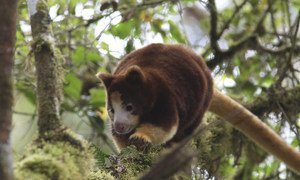FROM THE FIELD: Conversations about Conservation

An Egongot indigenous man balances on a yantok vine as he crosses from one tree to another in Dipaculao, Aurora, in the Philippines. (23 March 2019)
9 August 2019
Indigenous peoples in the Philippines are increasingly involved in the national conversation about protecting and conserving the South East Asian country’s key biodiversity areas, thanks to support from the United Nations Development Programme (UNDP).
It is estimated that some 85 per cent of these areas are home to indigenous communities, who live in direct contact with nature and who have the traditional knowledge and skills to protect the environment.
But a combination of unsustainable tourism, poorly planned infrastructure development and the erosion of indigenous leadership in conservation, has meant that many habitats are under threat and biodiversity could be lost.
For this year's International Day of the World's Indigenous People, marked annually on 9 August read more here about how UNDP is helping to bring indigenous people back into the conversation about conservation.



No comments:
Post a Comment